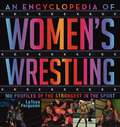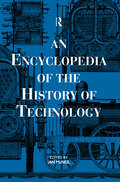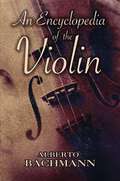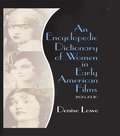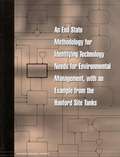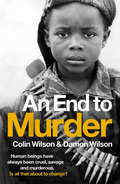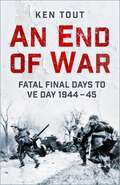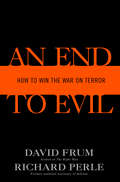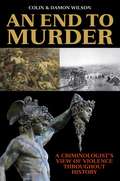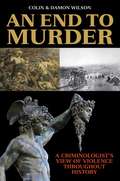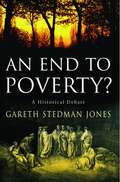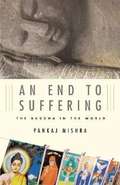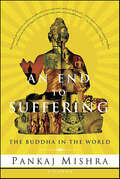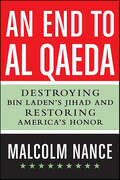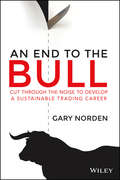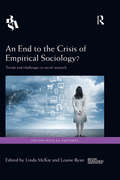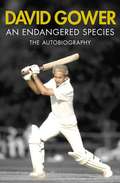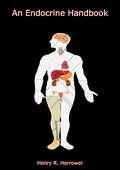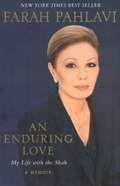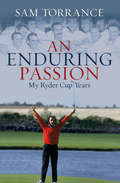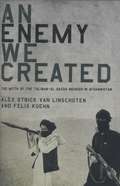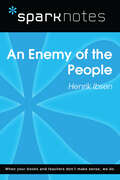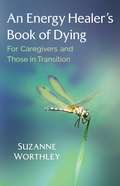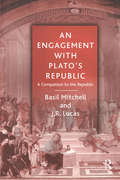- Table View
- List View
An Encyclopedia of Women's Wrestling: 100 Profiles of the Strongest in the Sport
by LaToya FergusonA comprehensive and fascinating illustrated look at women&’s professional wrestling, including 100 profiles of superstars from around the world. Women&’s pro wrestling has existed in the USA since the 1930s, and this colorful encyclopedia references the fashion, fun, and drama of the sport through the years and around the world. Focusing on 100 competitors—from current faves Sasha Banks and Charlotte Flair, to Germany's Jazzy Gabert, Japan&’s Io Shirai, and Canada's LuFisto, to legends like The Fabulous Moolah, Sable, Ivory, and Lita—it includes relevant stats and each one&’s compelling story. Written by noted authority LaToya Ferguson, this engaging history is great for anyone interested in powerful women, fantastic costumes, and pro wrestling itself.
An Encyclopedia of the History of Technology (Routledge Companion Encyclopedias)
by Ian McNEIL* 22 sections cover the entire field of the history of technology and each section summarises the development of its subject from the earliest times to the present day* Written without unnecessary jargon* 2 extensive indexes of Names and Topics* Usefully illustrated with 150 black & white photographs and line drawings to explain key advances`Contain[s] a vast amount of reliable information over a very wide field. It is certainly a work of which I shall myself make frequent use ... it deserves to find a place ... in every reference library.' - Times Higher Education Supplement`The coverage is excellent ... a most valuable single-volume source which for its comprehensiveness and ease of reference will earn its place in both specialist and general reference collections.' - Reference Reviews`Informative and comprehensive, remarkable in its coverage ... covers every aspect of technology from the Stone Age to the Space Age ... will undoubtedly help readers to get a grip on and feel of an enormous range of subjects ... An invaluable and practical addition to most office bookshelves or libraries.' - New Civil Engineer`The authors represented in this book are to be congratulated for their readable and reliable surveys of the past and present status of the major areas where mankind has harnessed science for the production of useful products and processes.' - Choice
An Encyclopedia of the Violin (Dover Books on Music)
by Alberto Bachmann"No list of twentieth-century landmarks in music reference would be valid without Bachmann's Encyclopedia."--American Reference Book Annual"If there were such an award as one for the best reprint of our day, surely this book by Alberto Bachmann would be way up front with the leaders."--American String TeacherOf the many books written about the violin, none offers the breadth and scope of this renowned reference. First published in 1925, it remains unsurpassed as a source of essential information on all aspects of the instrument. It traces the evolution of technique from the 1800s onward, in addition to examining the violin's construction and manufacture, listing American and European makers, and offering a biographic section on chamber music ensembles.Seventy-three rare photographs complement the text, which features an introduction by the legendary violinist Eugène Ysaÿe and a glossary of music and musical terms. Written by a concert violinist and composer, this remarkable handbook is a must for professionals, amateurs, teachers, and students.
An Encyclopedic Dictionary of Women in Early American Films: 1895-1930
by Denise LoweExamine women&’s contributions to film-in front of the camera and behind it! An Encyclopedic Dictionary of Women in Early American Films: 1895-1930 is an A-to-Z reference guide (illustrated with over 150 hard-to-find photographs!) that dispels the myth that men dominated the film industry during its formative years. Denise Lowe, author of Women and American Television: An Encyclopedia, presents a rich collection that profiles many of the women who were crucial to the development of cinema as an industry-and as an art form. Whether working behind the scenes as producers or publicists, behind the cameras as writers, directors, or editors, or in front of the lens as flappers, vamps, or serial queens, hundreds of women made profound and lasting contributions to the evolution of the motion picture production. An Encyclopedic Dictionary of Women in Early American Films: 1895-1930 gives you immediate access to the histories of many of the women who pioneered the early days of cinema-on screen and off. The book chronicles the well-known figures of the era, such as Alice Guy, Mary Pickford, and Francis Marion but gives equal billing to those who worked in anonymity as the industry moved from the silent era into the age of sound. Their individual stories of professional success and failure, artistic struggle and strife, and personal triumph and tragedy fill in the plot points missing from the complete saga of Hollywood&’s beginnings. Pioneers of the motion picture business found in An Encyclopedic Dictionary of Women in Early American Films include: Dorothy Arnzer, the first woman to join the Directors Guild of America and the only female director to make a successful transition from silent films to sound Jane Murfin, playwright and screenwriter who became supervisor of motion pictures at RKO Studios Gene Gauntier, the actress and scenarist whose adaptation of Ben Hur for the Kalem Film Company led to a landmark copyright infringement case Theda Bara, whose on-screen popularity virtually built Fox Studios before typecasting and overexposure destroyed her career Madame Sul-Te-Wan, née Nellie Conley, the first African-American actor or actress to sign a film contract and be a featured performer Dorothy Davenport, who parlayed the publicity surrounding her actor-husband&’s drug-related death into a career as a producer of social reform melodramas Lois Weber, a street-corner evangelist who became one of the best-known and highest-paid directors in Hollywood Lina Basquette, the "Screen Tragedy Girl" who married and divorced studio mogul Sam Warner, led The Hollywood Aristocrats Orchestra, claimed to have been a spy for the American Office of Strategic Services during World War II, and became a renowned dog expert in her later years and many more! An Encyclopedic Dictionary of Women in Early American Films: 1895-1930 also includes comprehensive appendices of the WAMPAS Baby Stars, the silent stars remembered in the Graumann Chinese Theater Forecourt of the Stars and those immortalized on the Hollywood Walk of Stars. The book is invaluable as a resource for researchers, librarians, academics working in film, popular culture, and women&’s history, and to anyone interested either professionally or casually in the early days of Hollywood and the motion picture industry.
An End State Methodology for Identifying Technology Needs for Environmental Management, with an Example from the Hanford Site Tanks
by Committee on Technologies for Cleanup of High-Level Waste in Tanks in the DOE Weapons ComplexThe National Academies Press (NAP)--publisher for the National Academies--publishes more than 200 books a year offering the most authoritative views, definitive information, and groundbreaking recommendations on a wide range of topics in science, engineering, and health. Our books are unique in that they are authored by the nation's leading experts in every scientific field.
An End To Murder: Human beings have always been cruel, savage and murderous. Is all that about to change?
by Colin Wilson Damon WilsonCreatively and intellectually there is no other species that has ever come close to equalling humanity’s achievements, but nor is any other species as suicidally prone to internecine conflict. We are the only species on the planet whose ingrained habit of conflict constitutes the chief threat to our own survival. Human history can be seen as a catalogue of cold-hearted murders, mindless blood-feuds, appalling massacres and devastating wars, but, with developments in forensic science and modern psychology, and with raised education levels throughout the world, might it soon be possible to reign in humanity’s homicidal habits? Falling violent crime statistics in every part of the world seem to indicate that something along those lines might indeed be happening. Colin and Damon Wilson, who between them have been covering the field of criminology for over fifty years, offer an analysis of the overall spectrum of human violence. They consider whether human beings are in reality as cruel and violent as is generally believed and they explore the possibility that humankind is on the verge of a fundamental change: that we are about to become truly civilised. As well as offering an overview of violence throughout our history – from the first hominids to the twenty-first century, touching on key moments of change and also indicating where things have not changed since the Stone Age – they explore the latest psychological, forensic and social attempts to understand and curb modern human violence. To begin with, they examine questions such as: Were the first humans cannibalistic? Did the birth of civilisation also lead to the invention of war and slavery? Priests and kings brought social stability, but were they also the instigators of the first mass murders? Is it in fact wealth that is the ultimate weapon? They look at slavery and ancient Roman sadism, but also the possibility that our own distaste for pain and cruelty is no more than a social construct. They show how the humanitarian ideas of the great religious innovators all too quickly became distorted by organised religious structures. The book ranges widely, from fifteenth-century Baron Gilles de Rais, ‘Bluebeard’, the first known and possibly most prolific serial killer in history, to Victorian domestic murder and the invention of psychiatry and Sherlock Holmes and the invention of forensic science; from the fifteenth-century Taiping Rebellion in China, in which up to 36 million died to the First and Second World Wars and more recent genocides and instances of ‘ethnic cleansing’, and contemporary terrorism. They conclude by assessing the very real possibility that the internet and the greater freedom of information it has brought is leading, gradually, to a profoundly more civilised world than at any time in the past.
An End of War: Fatal Final Days to VE Day, 1945
by Ken ToutAfter D-Day in 1944 many British troops believed the war would be over by Christmas. The German Army in Normandy had been destroyed, but by Christmas the Allies were still fighting through Holland, whilst the Germans had reorganised and were fighting back. Ken Tout, using his own experiences on the frontline and interviews with many veterans, recounts how the last gasps of the German Army saw some of the fiercest and most fanatical fighting of the whole war. Major offensives include Hitler’s last desperate attempt to reverse the tide of war in the Battle of the Bulge and the Western Allies’ epic struggle to cross the Rhine. Also explored are the lesser known, but no less important, battles for the Hochwald and Reichwald, and the extraordinary journey of the Polish 1st Armoured Division from defeat and exile to final victory. This last year of war is filled with stories from the tragedy of whole groups of men being frozen to death in battle areas to the triumph of logistics, ingenuity and bravery. Soldiers, who had lived for so long under the horrors of war that as they neared the end their desperate desire to survive grew ever stronger, speak of how these last battles took their toll on a wearied army. Fighting continued up to VE Day in May and some units were in action for days longer as confusion reigned about the enemy surrender. Even after the fighting had finished, the war was not over for these men who had to round up and guard German prisoners of war, and watch over thousands of displaced people. As our experiences in Iraq and Afghanistan remind us today, war does not necessarily end when a ceasefire is declared.
An End to Evil
by David Frum Richard PerleAn End to Evil charts the agenda for what's next in the war on terrorism, as articulated by David Frum, former presidential speechwriter and bestselling author of The Right Man, and Richard Perle, former assistant secretary of defense and one of the most influential foreign-policy leaders in Washington. This world is an unsafe place for Americans--and the U.S. government remains unready to defend its people. In An End to Evil, David Frum and Richard Perle sound the alert about the dangers around us: the continuing threat from terrorism, the crisis with North Korea, the aggressive ambitions of China. Frum and Perle provide a detailed, candid account of America's vulnerabilities: a military whose leaders resist change, intelligence agencies mired in bureaucracy, diplomats who put friendly relations with their foreign colleagues ahead of the nation's interests. Perle and Frum lay out a bold program to defend America--and to win the war on terror. Among the topics this book addresses: * why the United States risks its security if it submits to the authority of the United Nations * why France and Saudi Arabia have to be treated as adversaries, not allies, in the war on terror * why the United States must take decisive action against Iran--now* what to do in North Korea if negotiations fail* why everything you read in the newspapers about the Israeli-Arab dispute is wrong * how our government must be changed if we are to fight the war on terror to victory--not just stalemate * where the next great terror threat is coming from--and what we can do to protect ourselves An End to Evil will define the conservative point of view on foreign policy for a new generation--and shape the agenda for the 2004 presidential-election year and beyond. With a keen insiders' perspective on how our leaders are confronting--or not confronting--the war on terrorism, David Frum and Richard Perle make a convincing argument for why the toughest line is the safest line.From the Hardcover edition.
An End to Murder
by Colin Wilson Damon WilsonHuman history can be seen as a catalog of cold-hearted murders, mindless blood-feuds, appalling massacres, and devastating wars. Creatively and intellectually there is no other species that has ever come close to equaling humanity's achievements, but nor is any other species as suicidally prone to internecine conflict. We are the only species on the planet whose ingrained habit of conflict and perpetual warfare constitutes the chief threat to our own survival. But, with developments in forensic science and modern psychology, and with raised education levels throughout the world, might it soon be possible to reign in humanity's homicidal habits? Falling violent crime statistics in every part of the world seem to indicate that something along those lines might indeed be happening.Colin Wilson is one of the most prolific writers on criminology and the human condition. His first book, The Outsider (1956), was an instant best seller and still influences the study of sociology today. In An End to Murder, the Wilsons assess whether human beings are in reality as cruel and violent as is generally believed. The book explores the possibility that humankind is on the verge of a fundamental change: that we are about to become truly civilized. The historical scope ranges widely, from fifteenth-century Baron Gilles de Rais, "Bluebeard", the first known and possibly most prolific serial killer in history, to Victorian domestic murder and the invention of psychiatry and Sherlock Holmes and the invention of forensic science; from the fifteenth-century Taiping Rebellion in China, in which up to 36 million died, to the First and Second World Wars and more recent genocides and instances of "ethnic cleansing", and contemporary terrorism.As well as offering an overview of violence throughout our history-from the first hominids to the twenty-first century, touching on key moments of change and also indicating where things have not changed since the Stone Age-the authors explore the latest psychological, forensic, and social attempts to understand and curb modern human violence.
An End to Murder: A Criminologist's View of Violence Throughout History
by Colin Wilson Damon WilsonHuman beings have always been cruel, savage, and murderous. Is that all about to change? Human history can be seen as a catalog of coldhearted murders, mindless blood feuds, appalling massacres, and devastating wars. Creatively and intellectually, there is no other species that has ever come close to equaling humanity’s achievements, but neither is any other species as suicidally prone to internecine conflict. We are the only species on the planet whose ingrained habit of conflict and perpetual warfare constitutes the chief threat to our own survival. In An End to Murder, the Wilsons assess whether human beings are in reality as cruel and violent as is generally believed. The book explores the possibility that humankind is on the verge of a fundamental change: that we are about to become truly civilized. Covering a wide-reaching history of violence from the first hominids to the twenty-first century, the book touches on key moments of change while also indicating where things have not changed since the Stone Age. It follows the history of violence from fifteenth-century baron Gilles de Rais (“Bluebeard”), the first known and possibly most prolific serial killer in history; to Victorian domestic murder, the invention of psychiatry, Sherlock Holmes, and the invention of forensic science; the fifteenth-century Taiping Rebellion in China, in which more than twenty million died; World Wars I and II; more recent genocides and instances of “ethnic cleansing”; and contemporary terrorism. As well as offering an overview of violence throughout our history, the authors explore the latest psychological, forensic, and social attempts to understand and curb modern human violence.
An End to Poverty? A Historical Debate
by Gareth Stedman JonesA renowned historian explores the history of arguments about poverty and globalization, and their relevance to contemporary political debates.
An End to Poverty?: A Historical Debate
by Gareth Stedman JonesIn the 1790s, for the first time, reformers proposed bringing poverty to an end. Inspired by scientific progress, the promise of an international economy, and the revolutions in France and the United States, political thinkers such as Thomas Paine and Antoine-Nicolas Condorcet argued that all citizens could be protected against the hazards of economic insecurity. In An End to Poverty? Gareth Stedman Jones revisits this founding moment in the history of social democracy and examines how it was derailed by conservative as well as leftist thinkers. By tracing the historical evolution of debates concerning poverty, Stedman Jones revives an important, but forgotten strain of progressive thought. He also demonstrates that current discussions about economic issues—downsizing, globalization, and financial regulation—were shaped by the ideological conflicts of the late eighteenth and early nineteenth centuries.Paine and Condorcet believed that republicanism combined with universal pensions, grants to support education, and other social programs could alleviate poverty. In tracing the inspiration for their beliefs, Stedman Jones locates an unlikely source-Adam Smith. Paine and Condorcet believed that Smith's vision of a dynamic commercial society laid the groundwork for creating economic security and a more equal society. But these early visions of social democracy were deemed too threatening to a Europe still reeling from the traumatic aftermath of the French Revolution and increasingly anxious about a changing global economy. Paine and Condorcet were demonized by Christian and conservative thinkers such as Burke and Malthus, who used Smith's ideas to support a harsher vision of society based on individualism and laissez-faire economics. Meanwhile, as the nineteenth century wore on, thinkers on the left developed more firmly anticapitalist views and criticized Paine and Condorcet for being too "bourgeois" in their thinking. Stedman Jones however, argues that contemporary social democracy should take up the mantle of these earlier thinkers, and he suggests that the elimination of poverty need not be a utopian dream but may once again be profitably made the subject of practical, political, and social-policy debates.
An End to Suffering: The Buddha in the World
by Pankaj MishraAn End to Suffering is a deeply original and provocative book about the Buddha's life and his influence throughout history, told in the form of the author's search to understand the Buddha's relevance in a world where class oppression and religious violence are rife, and where poverty and terrorism cast a long, constant shadow. Mishra describes his restless journeys into India, Pakistan, and Afghanistan, among Islamists and the emerging Hindu middle class, looking for this most enigmatic of religious figures, exploring the myths and places of the Buddha's life, and discussing Western explorers' "discovery" of Buddhism in the nineteenth century. He also considers the impact of Buddhist ideas on such modern politicians as Gandhi and Nelson Mandela. As he reflects on his travels and on his own past, Mishra shows how the Buddha wrestled with problems of personal identity, alienation, and suffering in his own, no less bewildering, times. In the process Mishra discovers the living meaning of the Buddha's teaching, in the world and for himself. The result is the most three-dimensional, convincing book on the Buddha that we have.
An End to Suffering: The Buddha in the World
by Pankaj MishraA searching, personal portrait of the Buddha and his enduring influence, East and West.Pankaj Mishra's An End to Suffering is a deeply original and provocative book about the Buddha's life and his influence throughout history, told in the form of the author's search to understand the Buddha's relevance in a world where class oppression and religious violence are rife, and where poverty and terrorism cast a long, constant shadow. Mishra describes his restless journeys into India, Pakistan, and Afghanistan, among Islamists and the emerging Hindu middle class, looking for this most enigmatic of religious figures, exploring the myths and places of the Buddha's life, and discussing Western explorers' "discovery" of Buddhism in the nineteenth century. He also considers the impact of Buddhist ideas on such modern politicians as Gandhi and Nelson Mandela.As he reflects on his travels and on his own past, Mishra shows how the Buddha wrestled with problems of personal identity, alienation, and suffering in his own, no less bewildering, times. In the process Mishra discovers the living meaning of the Buddha's teaching, in the world and for himself. The result is the most three-dimensional, convincing book on the Buddha that we have.
An End to al-Qaeda: Destroying Bin Laden's Jihad and Restoring America's Honor
by Malcolm NanceOsama Bin Laden is unquestionably the leader of the world's most deadly terrorist cult. He has perverted the teachings of Islam to create a fringe religious ideology, Bin Ladenism, where only al-Qaeda speaks for God. In his cult, suicide bombing is the highest form of worship and the mass murder of Muslims proves one's devotion. Al-Qaeda's 9/11 attack on the United States was just a small part of Bin Laden's long-term strategy to win a civil war for control of Islam. By fighting his terrorists solely with bullets and bombs and ignoring his war on Islam, we have bolstered Bin Laden's recruiting efforts abroad, undermined civil liberties and economic security at home and tarnished America's reputation internationally.Career intelligence officer Malcolm Nance proposes a quantum shift in how to eliminate al-Qaeda in less than twenty-four months, while recreating America's reputation as a force for good around the world. His plan includes:· Exposing al-Qaeda's mission to create a nuclear armed terror Emirate, incite a Muslim civil war and eventually seize of control of Islam.· Challenging and breaking the perceived spiritual link between the mainstream Islam and al-Qaeda's cultist ideology. · Attacking al-Qaeda fighters through precision intelligence and special operations missions, thereby reducing the deaths of innocent civilians.· Reframing and restoring America's shattered image in the developing world in order to support the global counterterrorism and counterinsurgency campaign.An End to al-Qaeda is both a revolutionary blueprint for destroying al-Qaeda and a fierce critique of America's poorly executed war on Bin Laden's terrorists.
An End to the Bull
by Gary NordenGo beyond technical analysis tools with this comprehensive lookat trading analysis Strategies for successful trading analysis for all markets areout there, but they're not often found in books for the generalpublic. So what are the secrets that professional traders know, butaren't willing to share? An End to the Bull: Cut Through thenoise to Develop A Sustainable Trading Career is a robust,honest resource that presents an alternative approach to themarkets, combining traditional technical tools with fundamentalanalysis, behavioral finance, and other key concepts to enrichreaders' trading knowledge. The author's comprehensive, educatedlook at the topic fills a huge need in the trading community, andis ideal both for novices and experienced traders.In An End to the Bull, Norden suggests that totalreliance on traditional technical analysis can lead to failure, andhas ended in disappointment for many. The book offers up a uniqueapproach for anyone looking to establish a sustainable tradingcareer based on a combination of the most tried-and-true methods.While it focuses especially on trading in Australia, the book is auseful resource for international traders at all levels.Explains why change is needed in trading analysis and presentsa revolutionary approach used by successful professionaltradersShares the core techniques and strategies to build knowledgeand establish a business-minded attitudeDiscusses more advanced ideas crucial for all traders,including understanding volatility and the typical flaws ofbehavioral financeGives solid advice for traders anywhere in the worldAn End to the Bull takes the mystery out of tradinganalysis and puts the power to navigating markets into the hands ofreaders.
An End to the Crisis of Empirical Sociology?: Trends and Challenges in Social Research (Sociological Futures)
by Louise Ryan Linda McKieResearch data are everywhere. In our everyday interactions, through social media, credit cards and even public transport, we generate and use data. The challenge for sociologists is how to collect, analyse and make best use of these vast arrays of information. The chapters in this book address these challenges using varied perspectives and approaches: The economics of big data and measuring the trajectories of recently arrived communities Social media and social research Researching 'elites', social class and 'race' across space and place Innovations in qualitative research and use of extended case studies Developing mixed method approaches and social network analysis Feminist quantitative methodology Teaching quantitative methods The book provides up to date and accessible material of interest to diverse audiences, including students and teachers of research design and methods, as well as policy analysis and social media.
An Endangered Species
by David GowerAs a cricketer, David Gower was famed for the elegance of his strokeplay as one of England's greatest batsmen and for his superb fielding. As a captain, he led his country to Ashes success, yet some queried his application because it all seemed to come to him so easily and effortlessly. But that was never the whole story: Gower was always committed and a great competitor, as this fascinating and frank book, looking back on his life and career, shows. Once he retired from the game, Gower built a new career for himself, first as team captain in the long-running TV comedy series They Think It's All Over, and then as an astute and charming presenter and commentator with Sky Sports. After more than 30 years as one of the most popular figures in the game, Gower now reveals there is so much more to his story than the cliched image of 'Lord' Gower flying in his Tiger Moth. He is a man of great insight, determination and drive, but who also knows there is always more to be had from life.
An Endocrine Handbook
by Henry R. HarrowerTHIS ENDOCRINE HANDBOOK is an attempt to inform our friends of the trends of progress in endocrine therapy, particularly those everyday phases of the subject upon which our work is based. It is not intended to be a review of glandular physiology or pathology, nor is it a treatise on the clinical aspects of endocrine or near-endocrine disorders.The reader will be able quickly to find much practical information that can be utilized in his work. While the manuscript for this book was being prepared, it occurred to the author that pointed excerpts from current medical literature might be given as more direct evidence of the validity of many views that are outlined here. These “Clinical Excerpts,” which follow each chapter, constitute an exceptionally valuable review of the subjects considered, and the index makes this therapeutic information much more accessible.
An Enduring Love
by Farah Pahlavi Patricia ClancyHer story began like a fairytale. At the age of, 21, Farah Diba married the Shah of Iran, Mohammed, Reza Shah Pahlavi. The world's press covered her coronation as empress. This is her autobiography. of Iran and, overnight she became an international celebrity.
An Enduring Passion: My Ryder Cup Years
by Sam TorranceThe Ryder Cup has defined Sam Torrance's life as a professional golfer. He has played with and against some of the greatest golfers the game has ever known, in the biggest and most high-pressure team event in golf.In An Enduring Passion, Torrance recalls every great moment in the two decades he spent pursuing Ryder Cup glory and looks at how the event has changed since he was trying to qualify for it as a player in the late 1970s. He examines the tactics and techniques of the captains he played under and those he played against, and tells how his huge experience as a player, and his vice captaincy to Mark James in the bear pit of Brookline, shaped the way he conducted his own captaincy at The Belfry in 2002. Everything he had learned about the Ryder Cup went into his leadership during that event, and when he raised the trophy aloft at the end of it all he knew he had learned the lessons well.Today, Sam Torrance is one of the most identifiable faces, and voices, of golf. It is the Ryder Cup, though, that made him, and this book is his enlightening account of the competition from an insider's perspective.
An Enemy We Created: The Myth Of The Taliban-al Qaeda Merger In Afghanistan
by Felix Kuehn Alex Strick van LinschotenTo this day the belief is widespread that the Taliban and al-Qaeda are in many respects synonymous, that their ideology and objectives are closely intertwined and that they have made common cause against the West for decades. Yet this view has hardly ever been scrutinized or testedempirically. This is all the more surprising given that the West's present entanglement in Afghanistan is commonly predicated on the need to defeat the Taliban in order to forestall further terrorist attacks worldwide. There is thus an urgent need to re-examine the known facts of the Taliban-alQaeda relationship and to tell the story of the Taliban's encounter with internationalist militant Islamism. In An Enemy We Created, Alex Strick van Linschoten and Felix Kuehn focus on the complexity of the relationship between the two groups and the individuals who established them. The book, which has already been cited prominently in The New Yorker, is the first to examine in detail the relationship from the Taliban's perspective based on Arabic, Dari and Pashtu sources, drawing on the authors many years of experience in southern Afghanistan, the Taliban s heartland. Theyalso interviewed Taliban decision-makers, field commanders and ordinary fighters while immersing themselves in Kandahar's society. The story of those individuals who were to become the key decision-makers, and the relationships among all those involved from the mid-1990s onward, reveal howfrequently the Taliban and al-Qaeda diverged rather than converged. An Enemy We Created concludes that there is room to engage the Taliban on two fundamental issues: renouncing al-Qaeda and guaranteeing that Afghanistan will not be a sanctuary for international terrorists. Yet the insurgency is changing, and it could soon be too late to find a political solution. The authors contend that certain aspects of the campaign in Afghanistan, especially night raids and attempts to fragment and decapitate the Taliban, are transforming the resistance, creating more opportunities for al-Qaeda and helping it to attain its objectives.
An Enemy of the People (SparkNotes Literature Guide Series)
by SparkNotesAn Enemy of the People (SparkNotes Literature Guide) by Henrik Ibsen Making the reading experience fun! Created by Harvard students for students everywhere, SparkNotes is a new breed of study guide: smarter, better, faster.Geared to what today's students need to know, SparkNotes provides:chapter-by-chapter analysis explanations of key themes, motifs, and symbols a review quiz and essay topics Lively and accessible, these guides are perfect for late-night studying and writing papers.
An Energy Healer’s Book of Dying: For Caregivers and Those in Transition
by Suzanne WorthleyA compassionate guidebook to the energetic stages of dying and how to offer practical support at each stage of the transition back to spirit • Explains the nine energetic levels of dying and what is happening during each stage, including how belief systems and energy blocks can affect the death process • Reveals what the dying person may see and experience, what to watch for in each stage, and specific ways to support your loved one during each phase • Explores the grieving process and offers helpful strategies for moving through it Written by a highly skilled intuitive energy worker, this compassionate guide reveals what is happening energetically during the transition back to spirit and details how to provide support in any phase of losing a loved one: before death, during the dying process, and afterward. Taking readers step-by-step through the nine energetic levels of dying, author Suzanne Worthley explains what is happening at each level or dimension energetically, what to watch for in each stage, and specific ways in which we can support our loved ones through their transition back to spirit. For each of the nine stages, she describes what the dying person may see and experience, including the stages of transition at which people undergo the familiar elements of near-death experiences, such as entering a tunnel, conducting a life review, or encountering angels, guides, loved ones in spirit, or a bright light. She explores what family members and friends may see and experience, such as spirit energy, and what they can do to offer practical support and emotional solace to their loved one. Examining how life force energy works as well as what Akashic records and soul contracts are, Worthley shares hospice case studies for each level of transition, so caregivers can see how belief systems and energy blocks in specific chakras affect the death process and why it is important to clear energy blocks like fear, anger, or guilt during life if possible. She explores the grieving process and offers helpful strategies for moving through it as well as &“at-a-glance&” reference tables of the nine stages and related healing strategies designed to be referred to by those holding vigil. Shedding light on one of the great mysteries of existence, An Energy Healer&’s Book of Dying offers a compact yet comforting guide to support you through this emotional, grief-filled, and exhausting time and help you bring solace to your loved one during the transition back to spirit.
An Engagement with Plato's Republic: A Companion to the Republic
by Basil Mitchell J.R. LucasOutrageous, unfashionable, politically incorrect though many of Plato's opinions undoubtedly are, we should not just dismiss them as thoughts now unthinkable, but think through them, recognising the force of the arguments that led Plato to enunciate them and consider the counter-arguments he might have marshalled to meet contemporary objections. This book encourages today's students to engage in Plato's thought, grapple with Plato's arguments, and explore the relevance of his arguments in contemporary terms. A text only comes alive if we make it our own; Plato's great work The Republic, often reads as though it were addressing the problems of the day rather than those of ancient Athens. Treating The Republic as a whole and offering a comprehensive introduction to Plato's arguments, Mitchell and Lucas draw students into an exploration of the relevance of Plato's thought to our present ideas about politics, society and education, as well as the philosophy of mathematics, science and religion. The authors bring The Republic to life. The first chapters help the reader to make sense of the text, either in translation or the original Greek. Later chapters deal with the themes that Plato raises, treating Plato as a contemporary. Plato is inexhaustible: he speaks to many different people of different generations and from different backgrounds. The Republic is not just an ancient text: it never ceases to be relevant to contemporary concerns, and it demands fresh discussion in every age.
